We went on our first ever nature hike in Costa Rica, oblivious of what to expect in terms of wildlife sightings. The hike was on the designated trails in Manuel Antonio National Park, on the Pacific Coast. After completing the entrance formalities, we had barely crossed the entrance, when we spotted a deer couple of meters off the trail. A minute later, we noticed a crowd that had gathered to observe a sloth chewing on a cecropia branch. Even before the sloth show was over, the next one had started. A gang of squirrel monkeys were flying across trees over our heads. All these were happening, while we were just a hundred odd meters into the park. Our first encounters of the wildlife in Costa Rica set the tone for our future hikes and a teaser of what this biodiverse paradise holds for us.
During our early days in Costa Rica, we were vaguely aware of all the wildlife species found in the country. But, after numerous hikes over the years, in the diverse ecosystems, we now have to our collection of memories, many amazing and entertaining encounters.
500,000 species of birds, mammals, reptiles, amphibians, insects call Costa Rica their home. If you are an enthusiast, an entire itinerary can revolve around exploring wildlife. Birding specific tours are common as well. Here is a guide (high level, of course. We would be kidding if we tried covering the entire biodiversity of Costa Rica in one blog post!) to the wildlife highlights of Costa Rica, what you can expect to see, and where.
Costa Rica Itinerary Ideas: A collection of different Costa Rica itineraries spanning over various lengths of days and covering a variety of different destinations and activities.
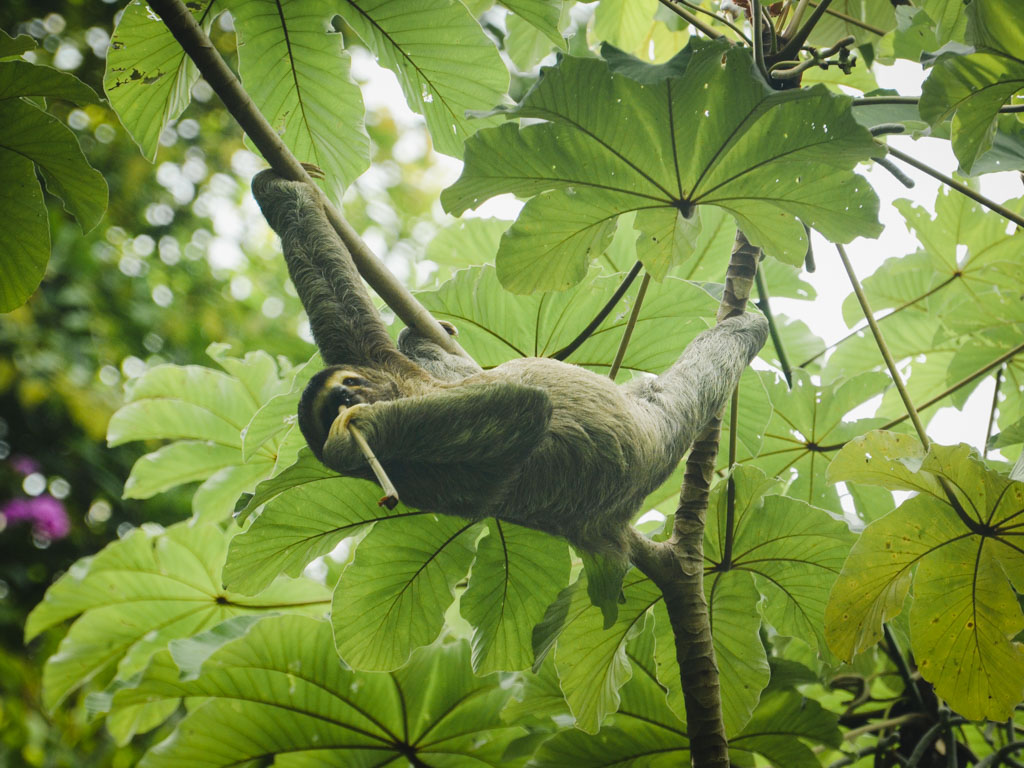
Mammals of Costa Rica
The most common mammals in Costa Rica are arboreal, the sloths and the monkeys. It is difficult to spot the big cats in the wild. However, there are several other interesting mammals that you are more likely to come across on the jungle hikes.
The Hanging Mammals (Arboreals)
- Sloths: The sloths remind us of the funny bank scene in the movie Zootopia (if you have not yet watched this animated movie, do watch!). In real life, they are as entertaining to watch. We have seen both three-toed sloths and two-toed sloths in Costa Rica. The three-toed ones are more common. Manuel Antonio, Bogarin Trail, Puerto Viejo are some of the places where we spotted them. The two-toed are less common and we were able to spot during our night walk in Monteverde.
- Monkeys: Monkeys are like the rulers of the trees in Costa Rica. 4 types of monkeys live in Costa Rica, White-faced Capuchin, Howler, Spider and Squirrel Monkeys. In most national parks or wildlife reserves in Costa Rica, you will be able to spot 2-3 species of monkeys. But in Corcovado National Park, all 4 species are found. Outside of the perimeters of national parks or reserves, you will commonly find monkeys in the trees if you venture a bit beyond the cities. So, whether you are walking on the streets of a village or lazing on the beach, remember to look up.
- Bats: There are many species of bats found all over Costa Rica. One species that stand out is the tiny white soft cotton-ball like bats known as Honduran Bats.
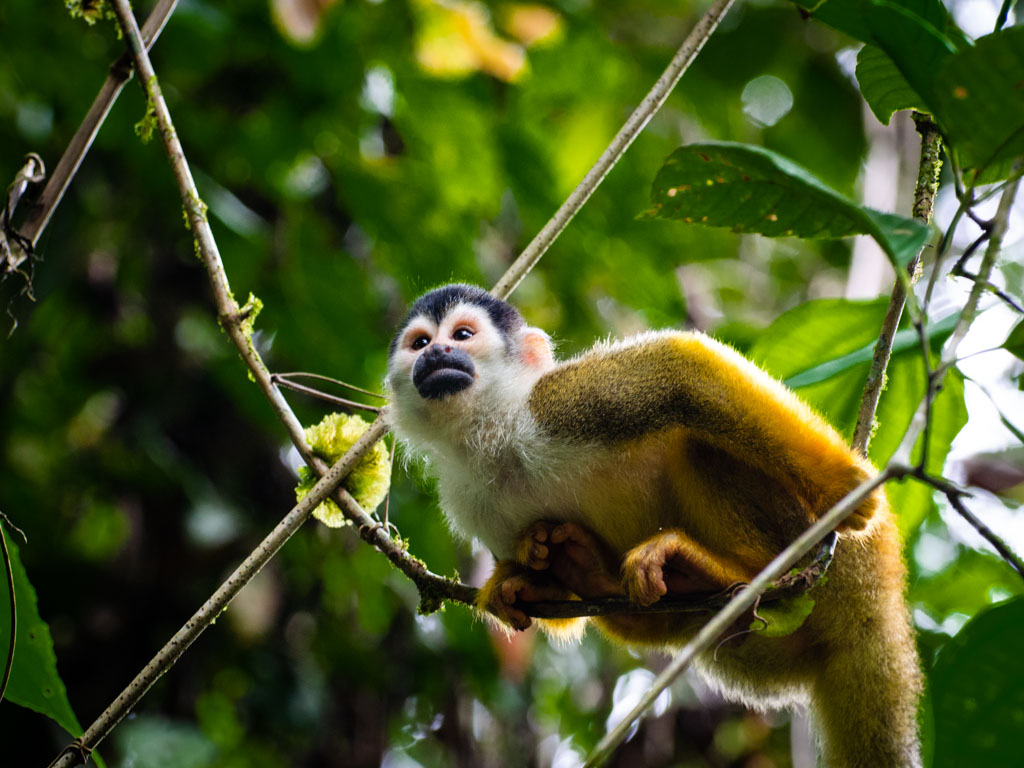
Mammals on the trails
- Baird’s Tapir: A Baird’s Tapir (locally called Danta) looks like a mix of a large pig and a small elephant. It is a gentle, herbivorous animal found in the wet areas of the forest, most commonly seen in Corcovado National Park. Our guide knew the places they frequent and we were lucky to find one during our tour.
- Collared Peccary: Peccaries are technically from the family of Tayassuide, distant relative of wild pigs. We could not distinguish them as anything other than pigs, besides they are bigger than domestic pigs and have large heads. They are also called javelinas because of their hidden sharp tusks that resemble javelins. This is another species that we first saw in Corcovado National Park.
- Ant Eater: Another furry beauty that is close to the family of sloths, but moves better! They have an elongated snout and tail, which make them look different from the sloths. Costa Rica has 3 different types of anteaters -lesser, giant and silky, the first being the most common. We found one during our hike in the Cabo Blanco Natural Reserve near the town of Cabuya.
- Agouti: The brownish-blackish rodent are seen in the Costa Rican rainforests and cloud forests. We have found them cross paths during our hikes on the trails. They are shy, but if feel threatened, can just freeze in one place until they think it is safe to move.
- Coati: These are the mischievous lot always looking for food and not shy of humans. You will find them all over Costa Rica, sometimes in large numbers sniffing for foods. Insider tip: if you ever record a video of a group of coatis, play it backwards and slow motion, the coatis will resemble dinosaurs!
- White-tailed Deer: The once endangered white-tailed deer is the National Animal of Costa Rica.
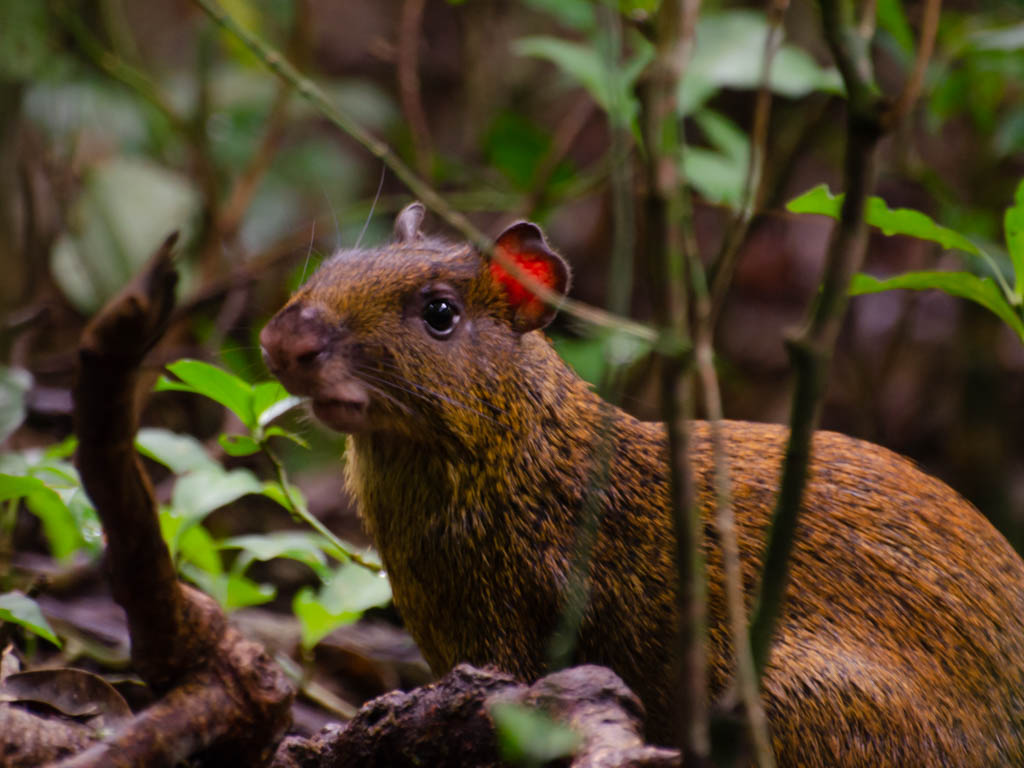
The Predator Cats
- Jaguar: The big cat is elusive and is extremely rare to find one in the wild. We heard all the interesting stories of jaguars attacking green sea turtles when they come to lay eggs on the beaches of Tortuguero National Park. Also, our guide at Corcovado National Park mentioned about a rare sighting from few years ago. But other than these exception stories, you are unlikely to come across a jaguar on the trails. The jaguar may be watching you though as you walk in the jungle!
- Ocelot: The spotted wild cat resembles a leopard but is way smaller. It is not very common to find them on the rainforest trails but they are less shy than the jaguars.
Aquatic Mammals
- Whales: The Pacific Coast of Costa Rica in the south welcomes the giant Humpback Whales between the months between July and October. Whale watching is a popular activity in the Marino Ballena National Park in Uvita and you may see the mother whales with the babies diving together during the season. You can also find humpback whales from north visit the tropical waters of Papagayo during the winter of the northern hemisphere.
- Dolphins: On the whale watching trips you may also come across these playful bunch in the Pacific coast.
Birds of Costa Rica
The various climatic zones and protected ecosystems make it suitable for different species of birds to thrive in the wild. There are over 900 species of birds in Costa Rica. If you are a keen and passionate birdwatcher, you can plan a birding focused Costa Rica itinerary.
Here are some of the families and species of birds that we have most often watched during our tours.
Birding is one of our top favorite activities in Costa Rica. Check out this article for ideas on other awesome things to do in Costa Rica.
Resplendent Quetzal and the Trogon Family
The Resplendent Quetzal is the most coveted bird on every birder’s wishlist. Like most bird species, the male quetzal is more attractive with its decorative crest, yellow bill, brilliant red and green plumage and long tail that runs far below the body.
Quetzals are found in the cloud forests of Costa Rica like Monteverde, San Gerardo de Dota and other regions in the Talamanca range. On our hikes in the trails of rainforests, we have spotted other species of the Trogons family, like the Orange-bellied trogons and the Yellow-bellied Trogons.
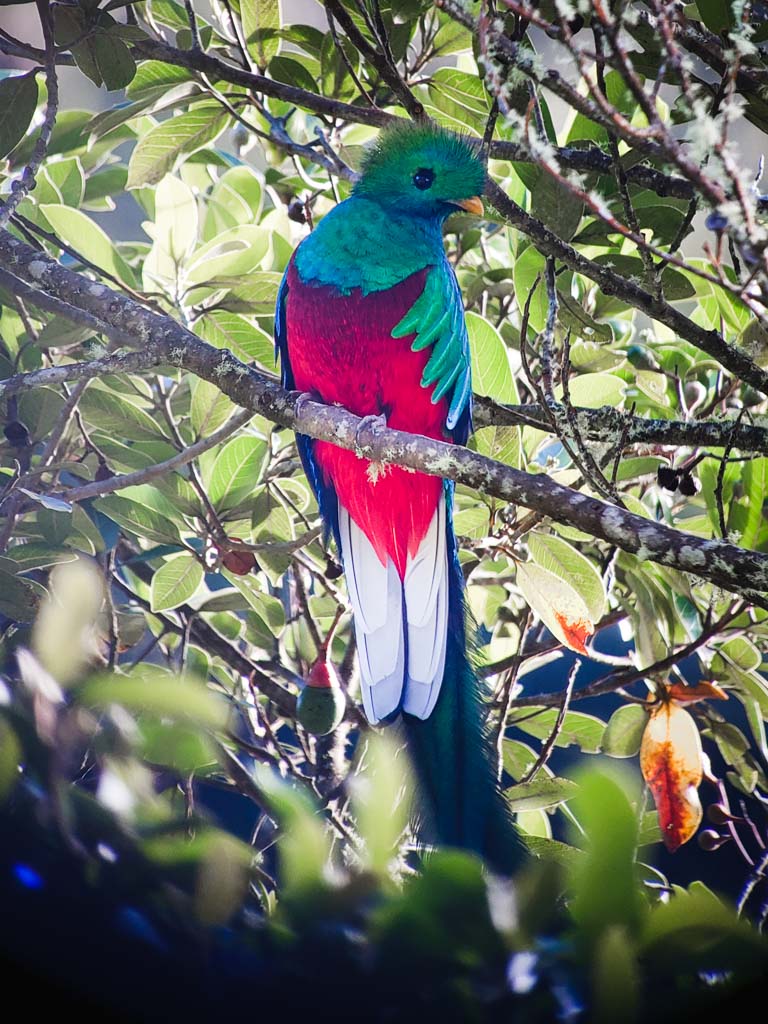
Toucans
There are 6 species of toucans found in the forests of Costa Rica. The Mandibled Toucan, Keel-billed Toucan, Fiery-billed Aracari, Collared Aracari and Emerald Toucanet are commonly seen in the wild or near natural feeders. Yellow-eared toucanets are rarer to spot.
The distinct bills, which look disproportionate to the body, are their most remarkable features. The bills make it interesting to watch how they throw the food in the air to catch and gulp it.
Hummingbirds
You cannot miss the hummingbirds if you are in Costa Rica. These tiny beauties buzz around the flowery bushes or feeders in the gardens. As they suck the nectar from the flowers, watch them flap their wings. More than 50 different species of hummingbirds inhabit Costa Rica.
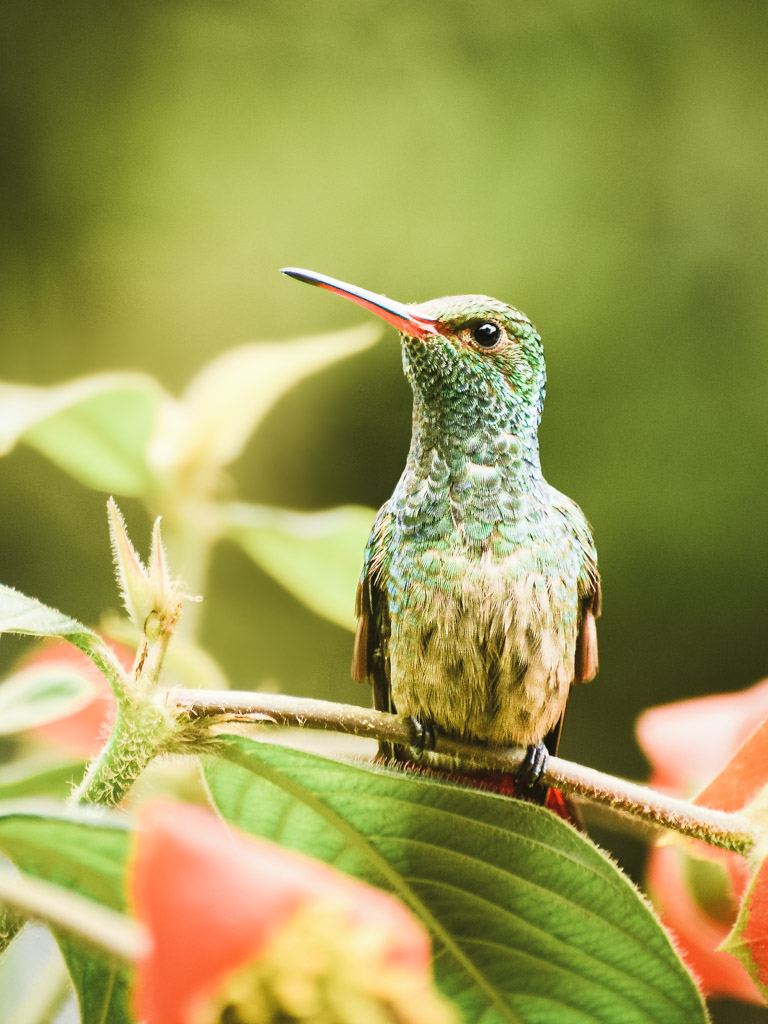
Tanagers
These beautiful birds come in all sorts of colors and many of them are regulars in the natural feeders. We have spotted blue-gray tanagers, flame-colored tanagers, golden-hooded tanagers, silver-throated tanagers, palm tanagers, green and red-legged honeycreepers, speckled tanagers in various natural feeders and also in landscaped gardens.
The summer tanager or the bay-headed tanager is less common but is absolutely beautiful. We spotted a summer tanager during our 10 km hike in the farthest end of Nicoya peninsula. (Note: Summer tanagers, although earlier belonged to the tanager family, are now considered to be part of the cardinal family.)
Macaws
These large birds not just make their presence felt with their shrill cries, but also stun with their colorful plumage. Scarlet Macaws and Great Green Macaws are the two types of macaws that you can expect to see on your visit to Costa Rica. The Scarlet Macaws are common in the Central Pacific region, near Jaco and Carara National Park. Whereas, we have seen the Great Green Macaws in Sarapiqui near the La Selva Biological Station and Cerro Tortuguero near Tortuguero.
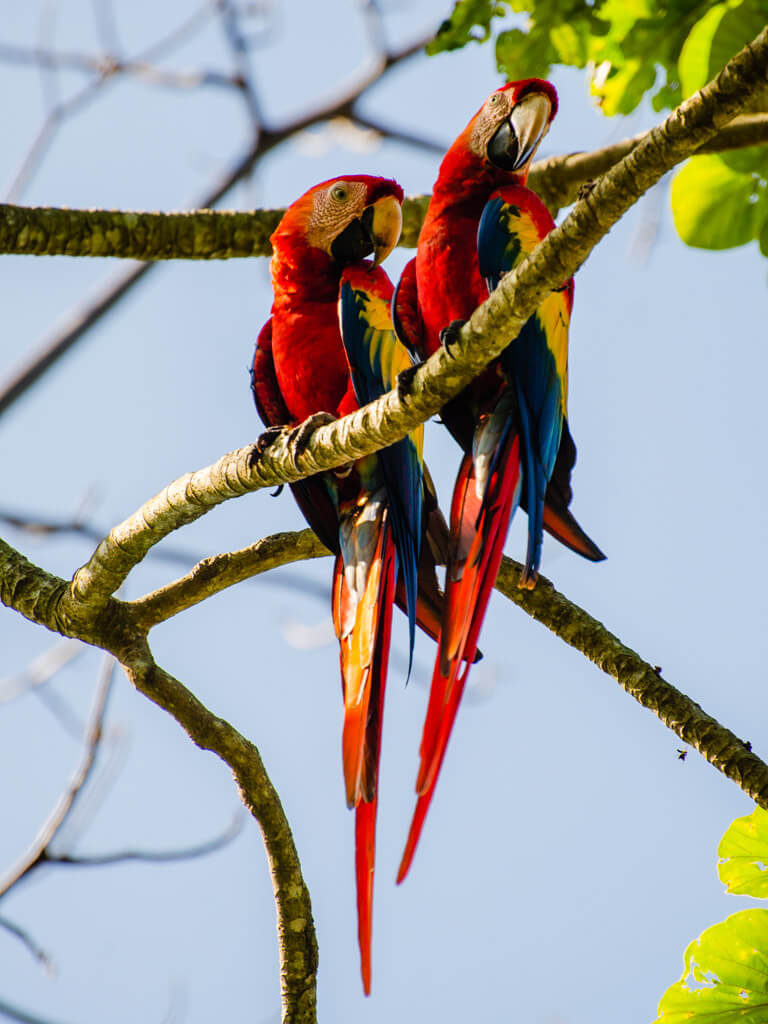
Motmots
This is another colorful species and can be found on the edges of the forests. We have found them several times at the start of the forest trails or beside the roads and they have waited patiently until we observed them to our satisfaction. 9 different species of motmots are found in Costa Rica. Some common ones we have seen are Turquoise-browed Motmot, Rufous Motmot or Lesson’s Motmot.
National Bird of Costa Rica: Clay-colored Thrush
The Clay-colored Thrush is the national bird of Costa Rica. It is a common bird and was designated as the national bird of Costa Rica for its proximity to the Costa Rican households and their easily identifiable call that work as natural morning alarm.
Aquatic Birds
The land birds take away all the attention in Costa Rica. However, if you are keeping your eyes open for the aquatic birds, there are quite a few as well. The Egrets and Cormorants are relatively common but you will find the Tiger Heron, Night Heron and Snake Bird near the rivers as well. The Boat-billed Heron is interesting for its boat-shaped beak. We spotted some on our trip to the Bogarin Trail in La Fortuna. Also, the Common Kingfisher and the Amazon Kingfisher are our other interesting finds near the water bodies.
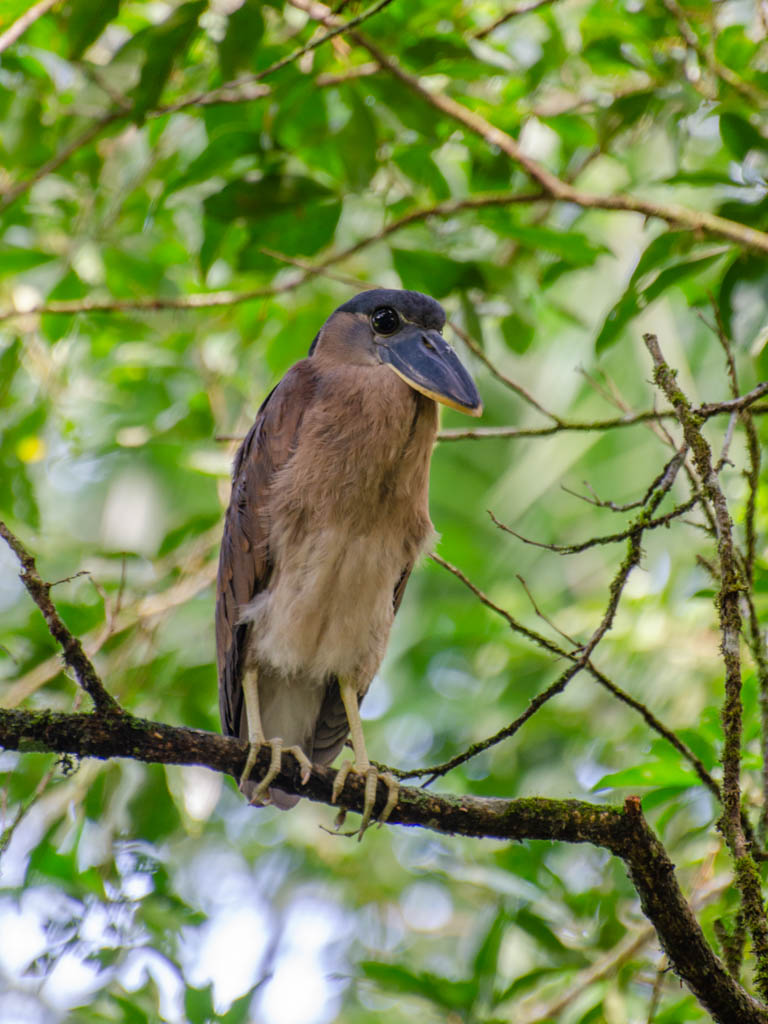
Our Other Favorites
Apart from the families, some of our other favorites are Chlorophonia, Long-Tailed Manakin, Male and Female Antshrikes, Acorn Woodpecker, Chestnut Woodpecker, Lineated Woodpecker, Red-hooded Barbet, Yellow-throated Euphonias, Magpie Jays to name a few.
The King Vulture and the Bellbird are in our wishlist for long and we hope to find them soon.
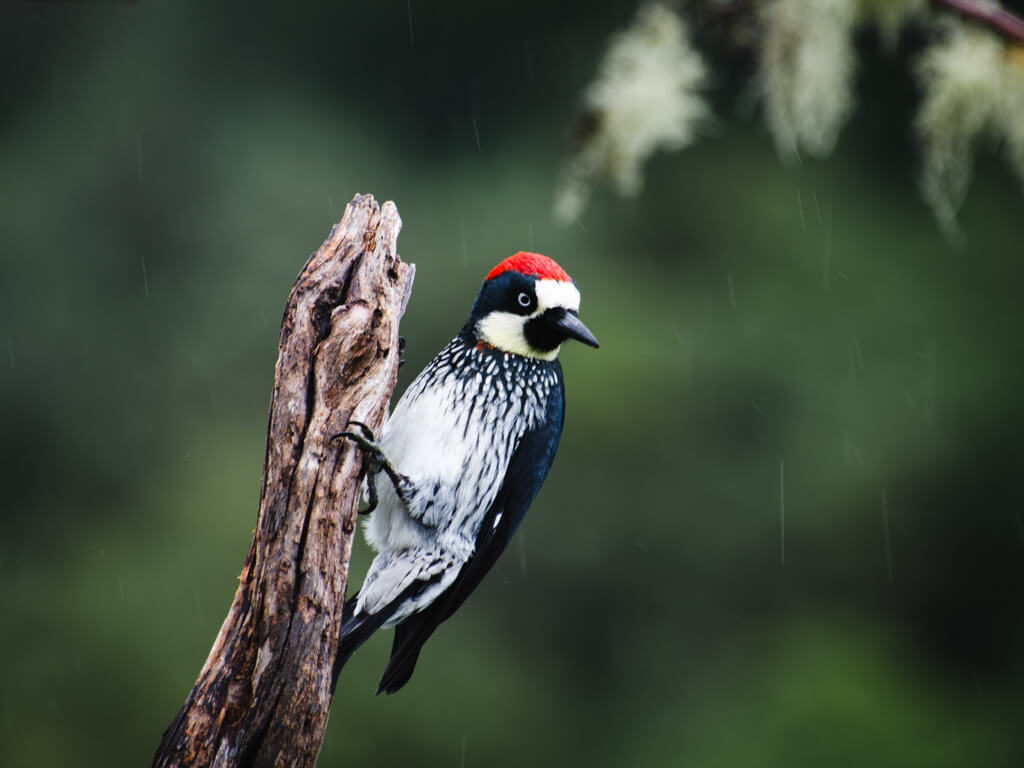
Amphibians of Costa Rica
- Red Eyed Tree Frog: The green tiny nocturnal frog is iconic of Costa Rica. If you find it in an alarmed state, you will see its true colors, orange inside feet and red eyes, thus justifying the name.
- Some of the other colorful frogs are the Blue Jeans Poison Dart Frog, Green and Black Poison Dart Frog and the Glass Frog.


From left: Red-eyed tree frog in La Fortuna, Green and Black Poison Dart Frog in Boca Tapada.
Reptiles of Costa Rica
- Crocodiles: You will find them across Costa Rica in marshlands and rivers. Tarcoles crocodile bridge over the Tarcoles river is the most common place to see crocodiles.
- Caimans: Close relatives of the crocodiles, they have incredible eyes which look like popping out of their heads. We found them in the canals of Tortuguero National Park and Boca Tapada.
- Iguanas: You will see these gentle dinosaurs in various sizes and shades, gloriously basking in the sun.
- Basilisk or Jesus Christ Lizard: Another exquisite lizard that can also run on the water, and has a crest on the back.
- Snakes: The Fer-de-Lance is the most venomous snake in Costa Rica, however, the Boa Constrictor is the most common one. The Golden Eye Lash Viper is popular for its bright yellow look and of course, its eyelash.
- Turtles: Several species of Sea Turtles find their way to the Costa Rican beaches for nesting. The Olive Ridley Turtles arrive in thousands at the Ostional Beach near Nosara. The endangered Green Sea Turtles arrive on the Tortuguero beach. You can go for guided turtle nesting tours in both Ostional and Tortuguero.
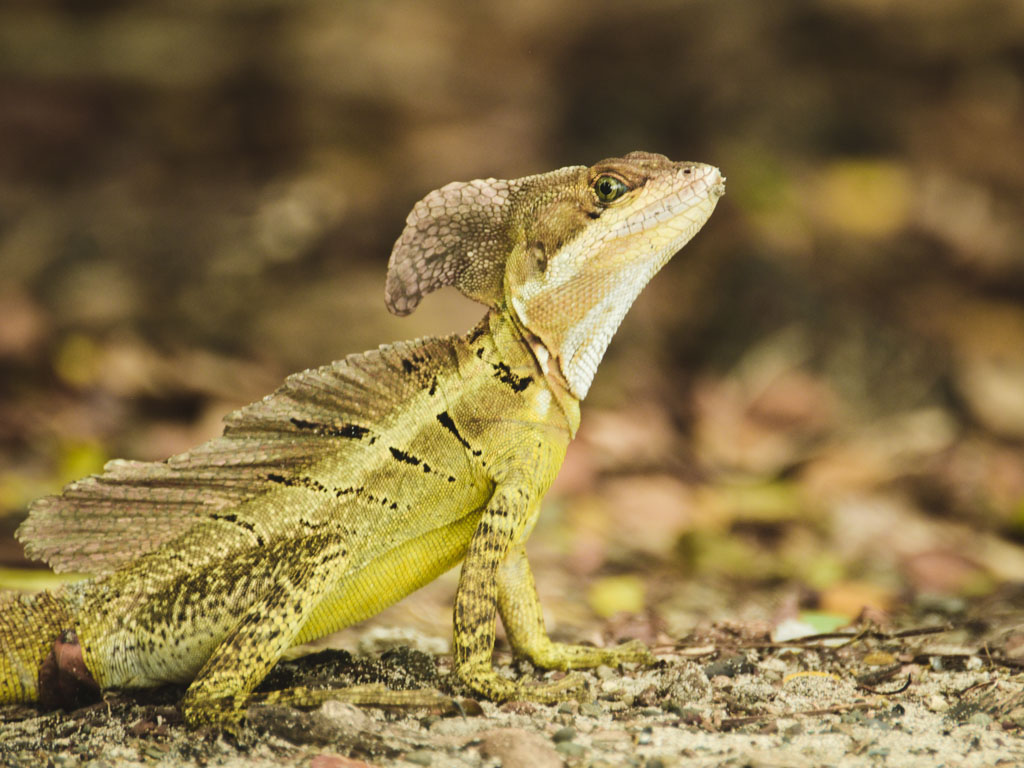


From left: Olive Ridley Sea-Turtle in Ostional, Crocodile in Sarapiqui.
Watch your YouTube video below for a visual feel of the remarkable sights of thousands of Olive Ridley sea turtles at Ostional Beach in Costa Rica.
Sloth: The National Symbol of Costa Rica
If you ask us to choose just one favorite from the various wildlife species in Costa Rica, it may be a tough ask but we do have an answer. As much as we love the monkeys and the exotic birds, our unanimous winner for favorite creature in Costa Rica is the sloth, both two-toed and three-toed! We could spend hours watching a sloth go about its activities as it seems to constantly set life goals of “what’s the rush”?
But it is not just the two of us, we share this affection for sloths with many others. Also, sloths are not just cute animals, they are also vulnerable for various reasons and needs dedicated protection and conservation. So, in 2021, sloth was declared a national symbol of Costa Rica.
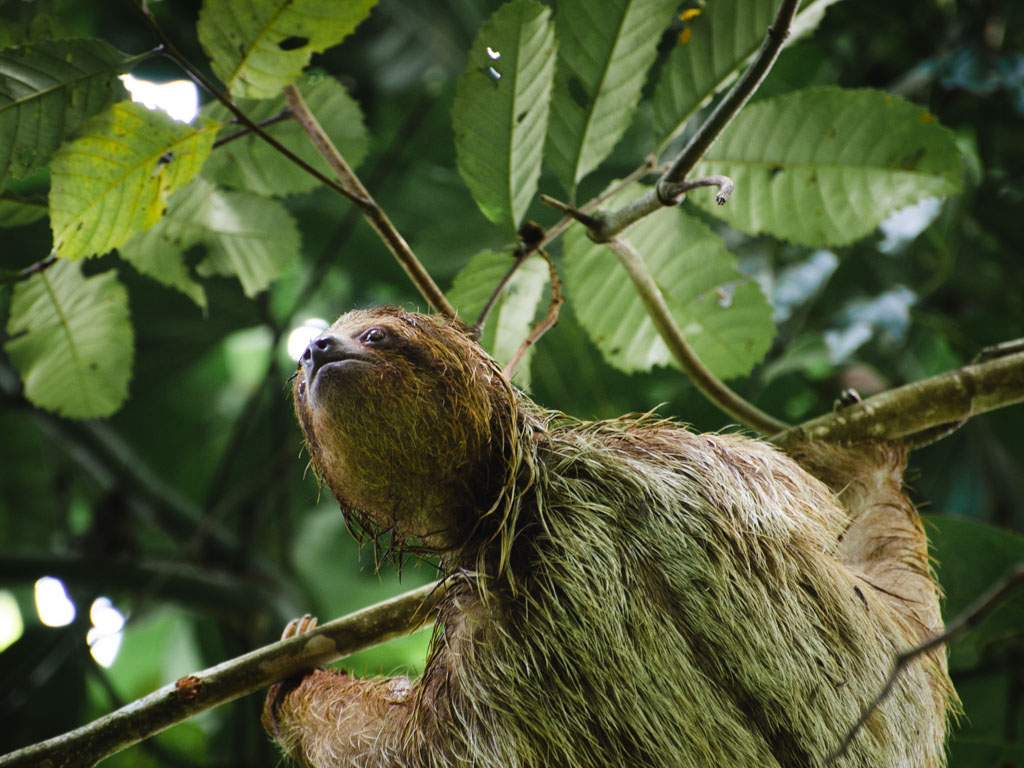
Final Thoughts on Wildlife of Costa Rica
It is difficult to do justice to cover the animals and birds of such a biodiverse country in one single post. These are some of the highlights that find place in a traveler’s wildlife bucket list of Costa Rica. We have seen wildlife enthusiasts return to Costa Rica over the years, seeking more sightings, and still get astonished with the natural abundance on every trip.
Have you been introduced to this incredible wealth of wildlife in Costa Rica yet? What is your favorite and what makes you want to come back for more interactions in the wild? Let us know in the comments.
Like the post? Pin it!


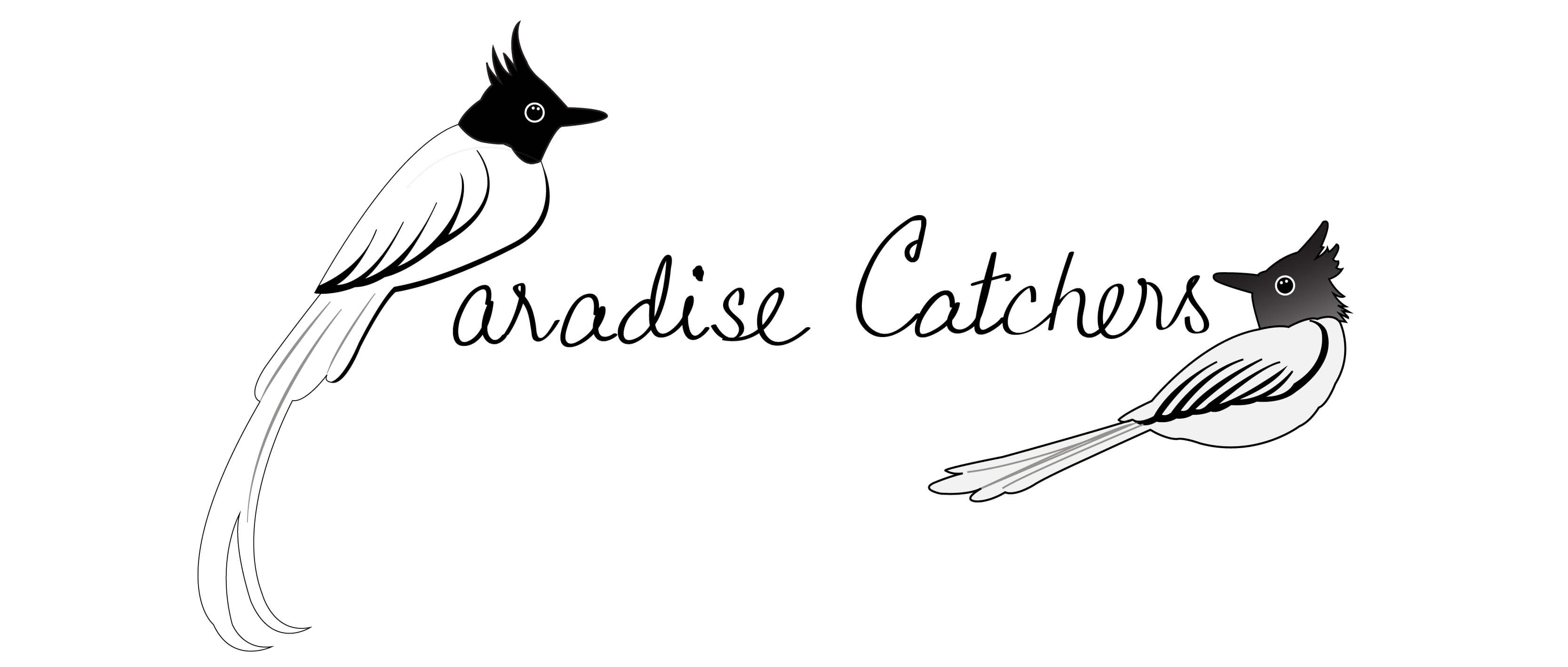

The presentation is more than an animal planet file of Costarica. Excellently described. Pics are sharp clear.
Wow! Thanks for your kind appreciation. Glad you enjoyed the article 🙂
Amazing article, I am going to Costa Rica soon and this helped prepare me for things to go see.
Thanks Jacob. Glad you found our article helpful for planning your trip. Enjoy Costa Rica! 🙂